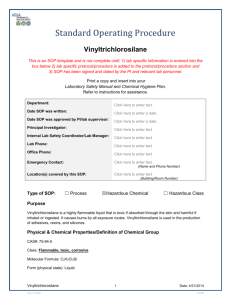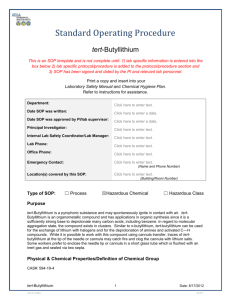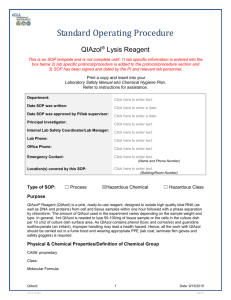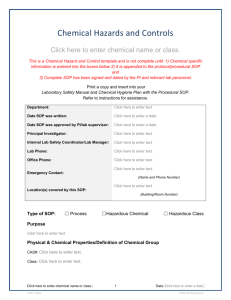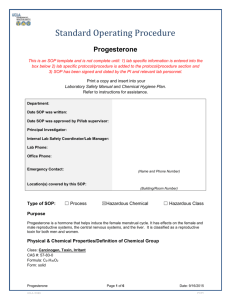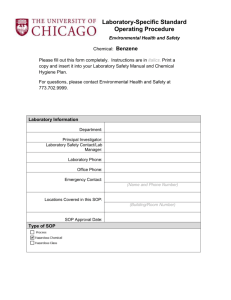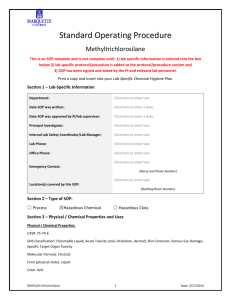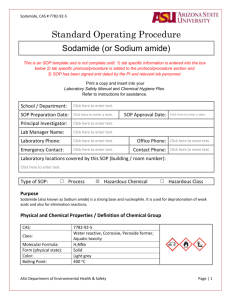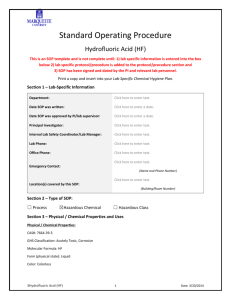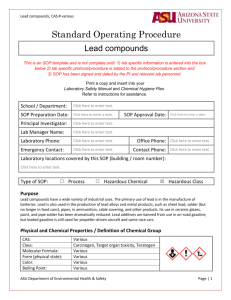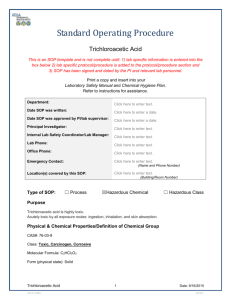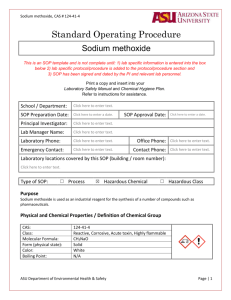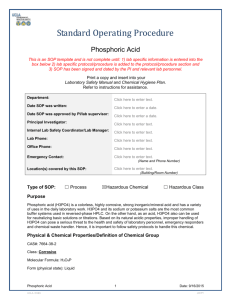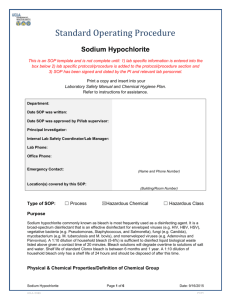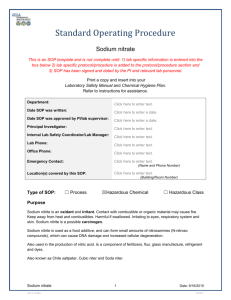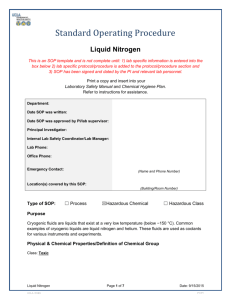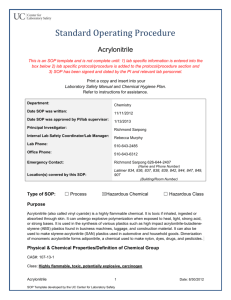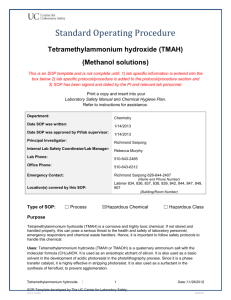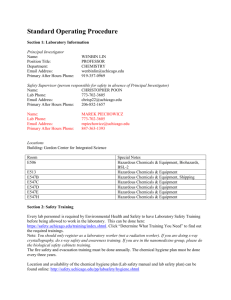Thiophenol SOP
advertisement
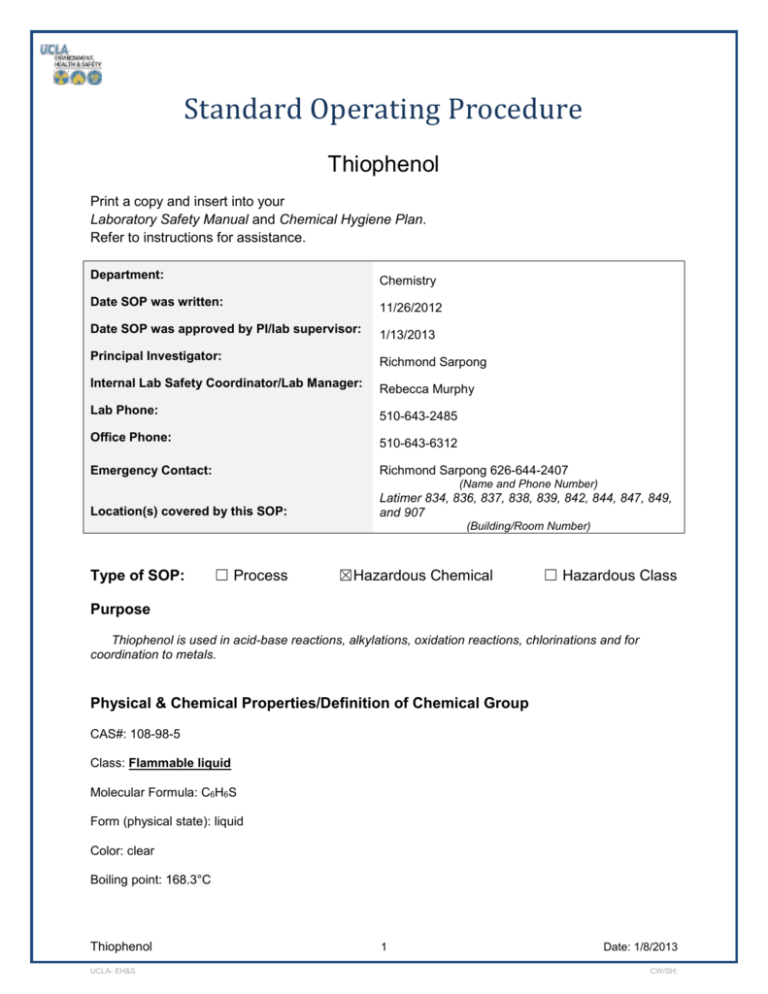
Standard Operating Procedure Thiophenol Print a copy and insert into your Laboratory Safety Manual and Chemical Hygiene Plan. Refer to instructions for assistance. Department: Chemistry Date SOP was written: 11/26/2012 Date SOP was approved by PI/lab supervisor: Principal Investigator: Richmond Sarpong Internal Lab Safety Coordinator/Lab Manager: Lab Phone: 1/13/2013 Rebecca Murphy 510-643-2485 Office Phone: 510-643-6312 Emergency Contact: Richmond Sarpong 626-644-2407 Location(s) covered by this SOP: Latimer 834, 836, 837, 838, 839, 842, 844, 847, 849, and 907 (Name and Phone Number) (Building/Room Number) Type of SOP: ☐ Process ☒Hazardous Chemical ☐ Hazardous Class Purpose Thiophenol is used in acid-base reactions, alkylations, oxidation reactions, chlorinations and for coordination to metals. Physical & Chemical Properties/Definition of Chemical Group CAS#: 108-98-5 Class: Flammable liquid Molecular Formula: C6H6S Form (physical state): liquid Color: clear Boiling point: 168.3°C Thiophenol UCLA- EH&S 1 Date: 1/8/2013 CW/SH: Potential Hazards/Toxicity Thiophenol is a flammable liquid and hazardous in case of skin contact. Harmful if swallowed, inhaled, or in contact with the skin or eyes. Avoid breathing spray/mist. May cause respiratory tract irritation. Severe overexposure can result in death. May be fatal if absorbed through the skin and have systemic effects on respiration and behavior/central nervous system. Has the following exposure limits: TWA: 0.5 from ACGIH (TLV) [United States] Has the following toxicity data: ORAL (LD50): Acute: 46.2 mg/kg [Rat], 267 mg/kg [Mouse]. DERMAL (LD50): Acute: 134 mg/kg [Rabbit]. Engineering Controls Handle using a chemical fume hood with good ventilation and electrically grounded lines and equipment. Personal Protective Equipment (PPE) NOTE: Lab-specific information on PPE selection may be included in Lab Specific Instructions. Respiratory protection NOTE: Lab personnel intending to use/wear a respirator mask must be trained and fit-tested by EH&S. This is a regulatory requirement. Refer to 8 CCR 5144 for selection of respirators. A respiratory protection program that meets 8 CCR 5144 must be followed whenever workplace conditions warrant use of a respirator. Respirators should be used only under any of the following circumstances: As a last line of defense (i.e., after engineering and administrative controls have been exhausted). When Permissible Exposure Limit (PEL) has exceeded or when there is a possibility that PEL will be exceeded. Regulations require the use of a respirator. An employer requires the use of a respirator. There is potential for harmful exposure due to an atmospheric contaminant (in the absence of PEL) As PPE in the event of a chemical spill clean-up process Thiophenol UCLA- EH&S 2 Date: 1/8/2013 CW/SH: Hand Protection Handle with gloves. Gloves must be inspected prior to use. Use proper glove removal technique (without touching glove's outer surface) to avoid skin contact with this product. Dispose of contaminated gloves after use in accordance with applicable laws and good laboratory practices. Wash and dry hands. For glove selection, go to: http://ehs.berkeley.edu/hs/63-laboratory-safety/94-glove-selectionand-usage.html Eye Protection Safety glasses with side shields or tightly fitting safety goggles. Use face shield (8-inch minimum) when appropriate. Use equipment for eye protection tested and approved under appropriate government standards such as NIOSH (US) or EN 166(EU) or ANSI Z87.1. Skin and Body Protection Long pants, closed-toed and closed-heeled shoes, cotton-based clothing/attire, and flame resistant (where appropriate) lab coat must be worn for protecting against chemical hazards. Additional PPE may be required if procedures or processes present additional risk. It is the responsibility of the PI to ensure that any additional PPE requirements are identified and communicated to research staff. Storage Thiophenol should be stored in a well-ventilated area away from incompatible substances. Use unbreakable secondary containment for the storage of acutely toxic chemicals. If the materials are volatile (or could react with moisture or air to form volatile toxic compounds), containers should be in a ventilated storage area. All containers of acutely toxic chemicals should be clearly labeled with chemical composition, known hazards, and warnings for handling. Chemicals that can combine to make toxic materials (e.g., acids and inorganic cyanides, which can generate hydrogen cyanide) should not be stored in the same secondary containment. Chemicals that have a limited shelf life need to be tracked and monitored. Chemicals that require refrigeration should be stored appropriately. Spill Response and Exposure Response Before beginning work with chemicals, review the relevant SOPs, Safety Data Sheets, and other chemical safety resources. Develop specific procedures for emergency response and chemical exposure or injury to staff, including any special first aid measures required for the relevant chemicals. Spill and Accident Procedure Note: These responses may not apply to all acutely toxic chemicals. Please review specific chemical SOPs and SDSs for specific response to spills and accidents. Always dial 911 and 510-642-9090 for assistance. Thiophenol UCLA- EH&S 3 Date: 1/8/2013 CW/SH: Chemical Spill Dial 911 Spill – Assess the extent of danger. Help contaminated or injured persons. Evacuate the spill area. Avoid breathing vapors. If possible, confine the spill to a small area using a spill kit or absorbent material. Keep others from entering contaminated area (e.g., use caution tape, barriers, etc.). Dial 911 and 510-642-9090 for assistance. Chemical Spill on Body or Clothes – Remove clothing and rinse body thoroughly in emergency shower for at least 15 minutes. Seek medical attention. Notify supervisor and EH&S immediately. Follow up with a call to 510-642-9090 to report the incident. Chemical Splash Into Eyes – Immediately rinse eyeballs and inner surfaces of eyelids with water from the emergency eyewash station for 15 minutes by forcibly holding the eye open. Seek medical attention. Notify supervisor and EH&S immediately. Follow up with a call to 510642-9090 to report the incident. Medical Emergency Dial 911 Life Threatening Emergency, After Hours, Weekends and Holidays – Dial 911 or go to the nearest emergency room. Note: All serious injuries must be reported to EH&S within 8 hours. Follow up with a call to 510-642-9090 to report the incident. Non-Life Threatening Emergency – Go to the Occupational Health Facility (Tang Health Center). After hours go to the nearest emergency room. Note: All serious injuries must be reported to EH&S within 8 hours. Follow up with a call to 510-642-9090 to report the incident. Needle stick/puncture exposure (as applicable to chemical handling procedure) – Wash the affected area with antiseptic soap and warm water for 15 minutes. For mucous membrane exposure, flush the affected area for 15 minutes using an eyewash station. Go to the Occupational Health Facility (Tang Health Center). After hours go to the nearest emergency room. Note: All needle stick/puncture exposures must be reported to EH&S within 8 hours. Follow up with a call to 510-642-9090 to report the incident. Hazardous Waste Disposal General hazardous waste disposal guidelines: Label Waste Label all containers with the label provided at http://ehs.berkeley.edu/hm/279-new-hazardous-wasteprogram-hwp.html. See the EH&S Fact Sheet, “Hazardous Waste Management” for general instructions on procedures for disposing of hazardous waste. Dispose of Waste Dispose of regularly generated chemical waste within six (6) months. Call EH&S for questions Safety Data Sheet (SDS) Location SDS can be accessed online at http://ucmsds.com Thiophenol UCLA- EH&S 4 Date: 1/8/2013 CW/SH: Protocol/Procedure (Add lab specific Protocol/Procedure here) --All work with thiophenol should be performed in a fume hood with the proper PPE worn at all times. - Protocol/Procedure for– Thiophenol CAS #(s) 108-98-5 Preparation Know the location of the nearest spill kit, fire extinguisher, eyewash, and safety shower before beginning work. Eliminate any incompatible materials from the potential spill area. Never work alone. Make sure there is another worker present who is also trained in the thiophenol SOP Lab-specific Information All work for this procedure is to take place in the designated fume hood.) Procedure/Use Scale Thiophenol is used in acid-base reactions, alkylations, oxidation reactions, chlorinations and for coordination to metals. 5 mL Engineering Controls/Equipment Up to 10 ml maximum used at one time. PPE (eye, face, gloves, clothing) Eye protection: Safety glasses with side shields or tightly fitting safety goggles. Use face shield (8-inch minimum) when appropriate. Face protection: Gloves: For light incidental (e.g., splash) use 0.3mm (12 mil) Viton butyl rubber gloves or for heavy extended (e.g. immersion), recommend 0.7mm (28 mil) fluorinated rubber gloves such as Sigma Aldrich Vitojet. Gloves. Clothing: Long pants, closedtoed and closed-heeled shoes, Thiophenol UCLA- EH&S 5 Date: 1/8/2013 CW/SH: Procedure Steps and Special Precautions for this Procedure After adding the desired amount of thiophenol, all needles, syringes, gloves, and flasks should be washed in a dilute aqueous solution of bleach for 1 hour, due to its strong stench. cotton-based clothing/attire, and flame resistant (where appropriate) lab coat must be worn for protecting against chemical hazards. Notes Initials of individuals using this procedure Thiophenol UCLA- EH&S Any deviation from this SOP requires approval from PI. 6 Date: 1/8/2013 CW/SH: Documentation of Training (signature and initials of all users is required) Prior to conducting any work with Thiopenol, designated personnel must provide training to his/her laboratory personnel specific to the hazards involved in working with the specific chemical(s) used, work area decontamination, and emergency procedures. The Principal Investigator must provide his/her laboratory personnel with a copy of this SOP and a copy of the SDS provided by the manufacturer. I have read and understand the content of this SOP: Name Signature Initials Identification Click here to enter text. Click here to enter a date. Click here to enter a date. Click here to enter a date. Click here to enter a date. Click here to enter a date. Click here to enter a date. Click here to enter a date. Click here to enter a date. Click here to enter a date. Click here to enter a date. Click here to enter text. Click here to enter text. Click here to enter text. Click here to enter text. Click here to enter text. Click here to enter text. Click here to enter text. Click here to enter text. Click here to enter text. Thiophenol UCLA- EH&S Date 7 Date: 1/8/2013 CW/SH: Click here to enter text. Click here to enter a date. Click here to enter a date. Click here to enter a date. Click here to enter a date. Click here to enter a date. Click here to enter a date. Click here to enter a date. Click here to enter a date. Click here to enter a date. Click here to enter a date. Click here to enter a date. Click here to enter a date. Click here to enter text. Click here to enter text. Click here to enter text. Click here to enter text. Click here to enter text. Click here to enter text. Click here to enter text. Click here to enter text. Click here to enter text. Click here to enter text. Click here to enter text. Thiophenol UCLA- EH&S 8 Date: 1/8/2013 CW/SH:
